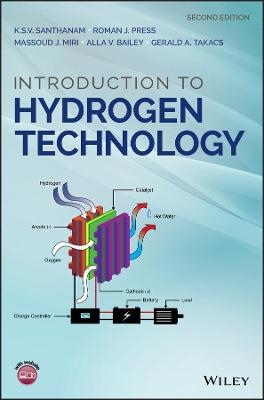
Introduction to Hydrogen Technology
John Wiley & Sons Inc (Verlag)
978-1-119-26554-2 (ISBN)
This new and completely updated edition of Introduction to Hydrogen Technology explains, at an introductory level, the scientific and technical aspects of hydrogen technology. It incorporates information on the latest developments and the current research in the field, including: new techniques for isolating and storing hydrogen, usage as a fuel for automobiles, residential power systems, mobile power systems, and space applications.
Introduction to Hydrogen Technology, Second Edition features classroom-tested exercises and sample problems. It details new economical methods for isolating the pure hydrogen molecule. These less expensive methods help make hydrogen fuel a very viable alternative to petroleum-based energy. The book also adds a new chapter on hydrogen production and batteries. It also provides in-depth coverage of the many technical hurdles in hydrogen storage. The developments in fuel cells since the last edition has been updated.
Offers new chapters on hydrogen production, storage, and batteries
Features new sections on advanced hydrogen systems, new membranes, greenhouse gas sensors and updated technologies involving solar and wind energies
Includes problems at the end of the Chapters, as well as solutions for adopters
This book is an introduction to hydrogen technology for students who have taken at least one course in general chemistry and calculus; it will also be a resource book for scientists and researchers working in hydrogen-based technologies, as well as anyone interested in sustainable energy.
K.S.V. SANTHANAM is a Professor in Rochester Institute of Technology's School of Chemistry and Materials Science. ROMAN J. PRESS is a Visiting Researcher at the Rochester Institute of Technology. MASSOUD J. MIRI is a Professor in Rochester Institute of Technology's School of Chemistry and Materials Science. ALLA V. BAILEY is a Principal lecturer in the School of Chemistry and Materials Science at Rochester Institute of Technology. GERALD A. TAKACS is a Professor in School of Chemistry and Materials Science at the Rochester Institute of Technology.
PREFACE ix
ABOUT THE COMPANION WEBSITE xi
1 AVAILABLE ENERGY RESOURCES 1
1.1 Civilization and the Search for Sustainable Energy 1
1.2 The Planet’s Energy Resources and Energy Consumption 4
1.3 The Greenhouse Effect and its Influence on Quality of Life and the Ecosphere 6
1.4 Nonrenewable Energy Resources 11
1.5 Renewable Energy Sources 20
1.6 Energy Storage 38
1.7 Energy Ethics 40
Problems 41
Multiple Choice Questions 41
Bibliography 43
2 CHEMISTRY BACKGROUND 45
2.1 Reversible Reactions and Chemical Equilibrium 45
2.2 Acid–Base Chemistry 52
2.3 Chemical Thermodynamics 62
2.4 Chemical Kinetics 78
2.5 Electrochemistry (Oxidation–Reduction Reactions) 99
2.6 Organic Chemistry 104
2.7 Polymer Chemistry 129
2.8 Photochemistry 154
2.9 Plasma Chemistry 165
Problems 173
Multiple Choice Questions 173
Bibliography 182
3 HYDROGEN PRODUCTION 189
3.1 Electrolysis 189
3.2 Thermolysis (Thermal Reactions Involving Solar Energy) 191
3.3 Photovoltaic Electrolysis 193
3.4 Plasma ARC Decomposition 195
3.5 Thermochemical Process (Thermal Decompositions by Processes
other than Solar Energy) 195
3.6 Photocatalysis 196
3.7 Biomass Conversion 200
3.8 Gasification 201
3.9 High-Temperature Electrolysis 202
3.10 Miscellaneous Methods 204
3.11 Comparative Efficiencies 204
Problems 207
References 208
4 HYDROGEN PROPERTIES 209
4.1 Occurrence of Hydrogen, Properties, and Use 209
4.2 Hydrogen as an Energy Carrier 217
4.3 Hydrogen Storage 219
Multiple Choice Questions 230
Bibliography 233
5 HYDROGEN INFRASTRUCTURE AND TECHNOLOGY 235
5.1 Production of Hydrogen 235
5.2 Hydrogen Transportation, Storage, and Distribution 249
5.3 Hydrogen Safety 252
5.4 Hydrogen Technology Assessment 254
Multiple Choice Questions 259
Bibliography 261
6 BATTERIES 265
6.1 Introduction 265
6.2 Definitions 274
6.3 Working Units 276
6.4 Examples of Selected Batteries 279
6.5 Conducting Polymer Batteries (Organic Batteries) 283
6.6 Practical Considerations 286
6.7 Electric Transportation 290
Problems 302
Multiple Choice Questions 303
Bibliography 303
7 FUEL CELL ESSENTIALS 307
7.1 Introduction 307
7.2 Definition of Fuel 309
7.3 What is a Fuel Value? 309
7.4 Why do we Want to use Hydrogen as Fuel? 312
7.5 Classification of Fuel Cells 312
7.6 Open Circuit Voltages of Fuel Cells 315
7.7 Thermodynamic Estimate of Fuel Cell Voltage 320
7.8 Efficiency of a Fuel Cell 322
7.9 Efficiency and Temperature 323
7.10 Influence of Electrode Material on Current Output 323
7.11 Pressure Dependence of Fuel Cell Voltage 324
7.12 Thermodynamic Prediction of Heat Generated in a Fuel Cell 328
7.13 Fuel Cell Management 329
7.14 Rate of Consumption of Hydrogen and Oxygen 334
7.15 Rate of Production of Water 335
7.16 Fuel Crossover Problem 337
7.17 Polymer Membranes for PEMFC 337
7.18 Parts of PEMFC and Fabrication 347
7.19 Alkaline Fuel Cells (AFCs) 355
7.20 Molten Carbonate Fuel Cell (MCFC) 357
7.21 Solid Oxide Fuel Cell (SOFC) 361
7.22 Flowchart for Fuel Cell Development 369
7.23 Relative Merits of Fuel Cells 369
7.24 Fuel Cell Technology 371
7.25 Fuel Cells for Special Applications 374
7.26 Fuel Cell Reformers 375
7.27 Fuel Cell System Architecture 376
Appendix 7: Redox Reactions in DMFC 383
Problems 384
Multiple Choice Questions 385
Bibliography 388
8 FUEL CELLS APPLICATIONS 393
8.1 Stationary Power Production 393
8.2 Fuel Cell Transportation 394
8.3 Micropower Systems 401
8.4 Mobile and Residential Power Systems 402
8.5 Fuel Cells for Space and Military Applications 403
8.6 Conclusion 404
Multiple Choice Questions 405
Bibliography 405
INDEX 407
| Erscheinungsdatum | 17.11.2017 |
|---|---|
| Verlagsort | New York |
| Sprache | englisch |
| Maße | 180 x 259 mm |
| Gewicht | 1021 g |
| Themenwelt | Naturwissenschaften ► Chemie ► Technische Chemie |
| Technik ► Elektrotechnik / Energietechnik | |
| Technik ► Umwelttechnik / Biotechnologie | |
| ISBN-10 | 1-119-26554-1 / 1119265541 |
| ISBN-13 | 978-1-119-26554-2 / 9781119265542 |
| Zustand | Neuware |
| Haben Sie eine Frage zum Produkt? |
aus dem Bereich


